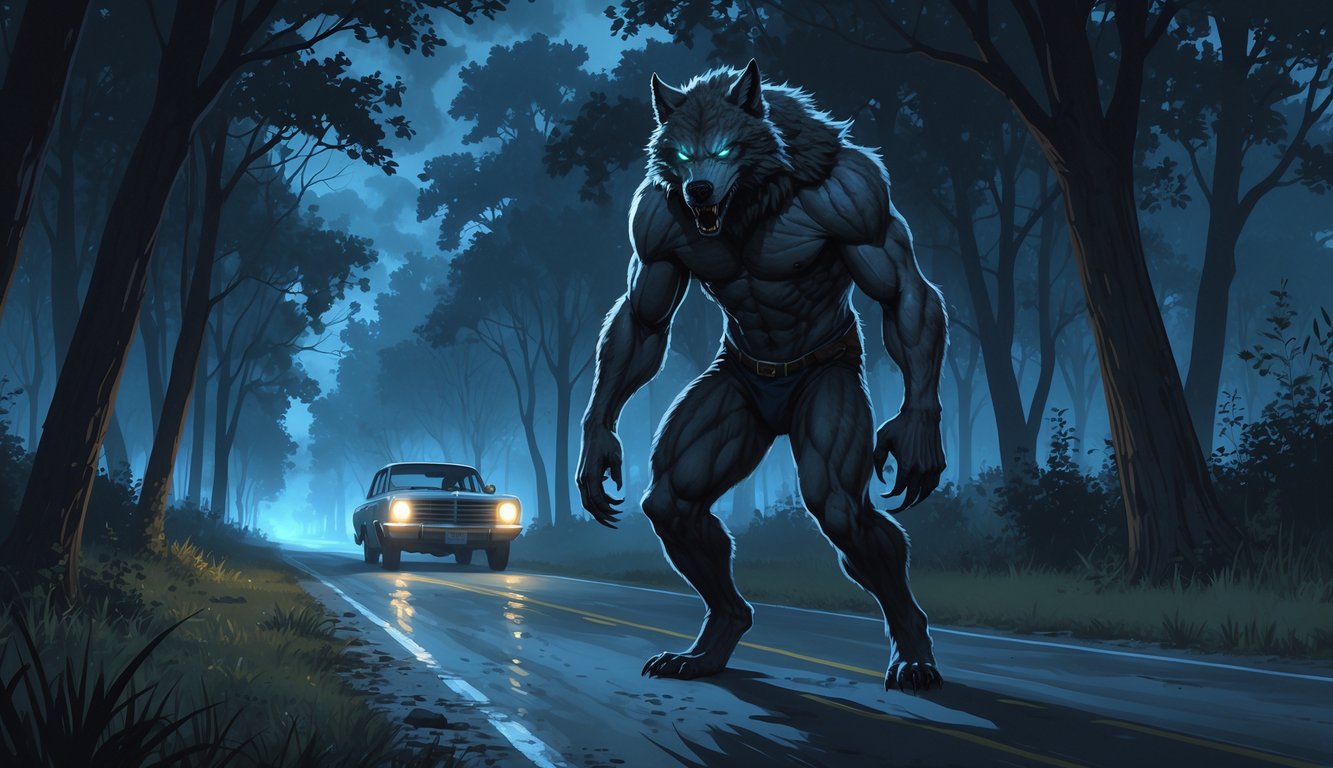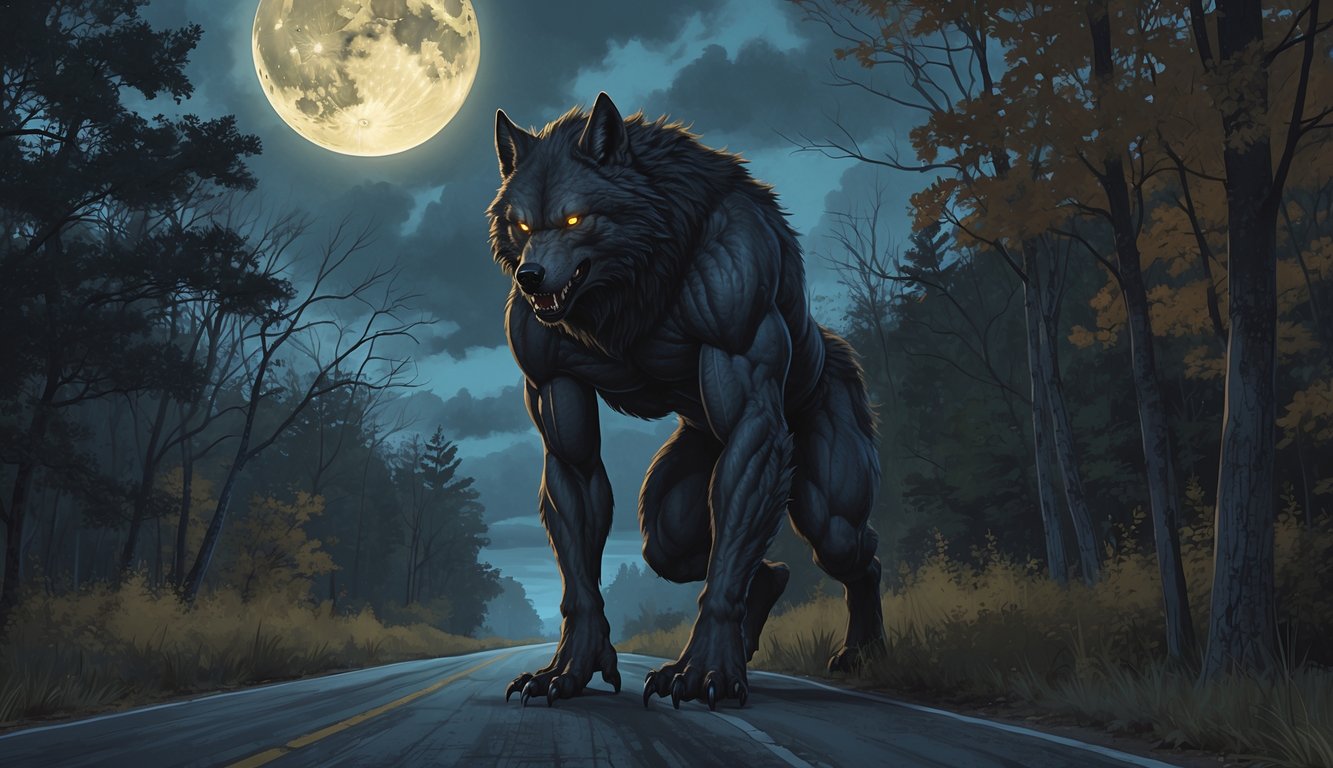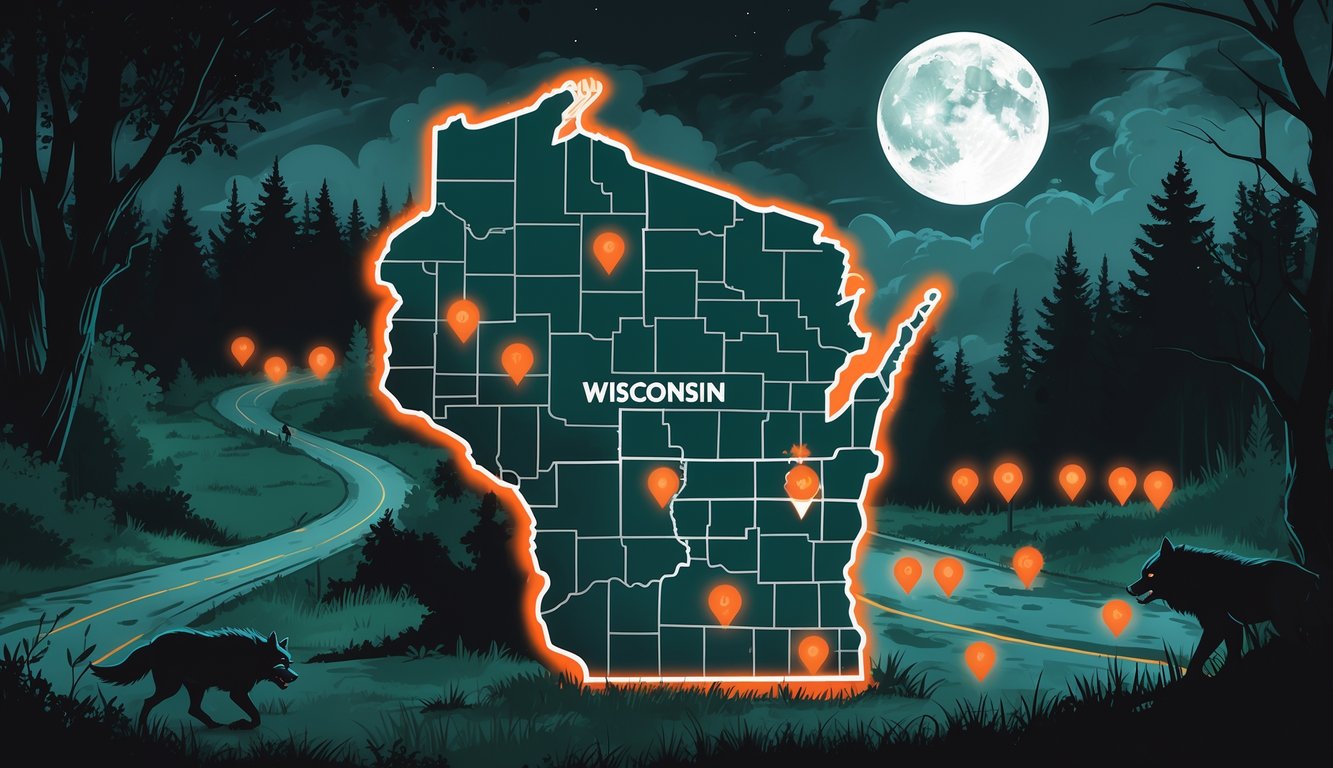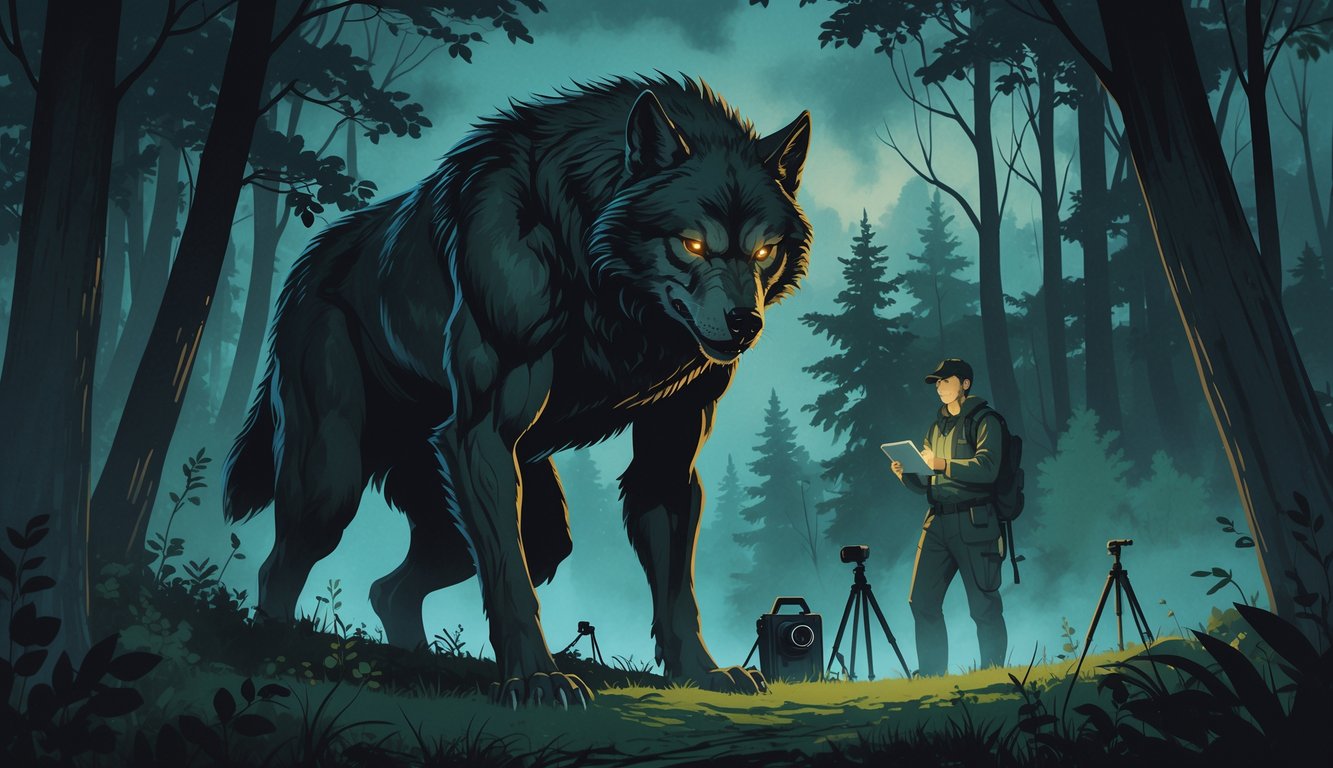On a quiet rural highway near Elkhorn, Wisconsin, locals have whispered about a strange creature for decades. People call it the Beast of Bray Road, and many describe it as a tall, fur-covered figure with a man’s build and a wolf’s head.
Farmers, drivers, and townsfolk have reported sightings of this mysterious animal since the late 20th century. Many believe it could be a type of werewolf.

The legend drew attention in the early 1990s, when local newspapers started publishing reports of sightings. Witnesses said the creature walked on two legs, had glowing eyes, and sometimes followed cars along dark country roads.
Interest spread beyond Wisconsin as cryptozoologists, paranormal enthusiasts, and curious travelers learned about the story. From its earliest sightings to journalist Linda Godfrey’s investigations, the Beast of Bray Road blends folklore, eyewitness testimony, and cultural fascination.
The Beast of Bray Road: Origins and Early Sightings
People have described seeing a large, wolf-like animal in rural areas near Elkhorn, Wisconsin. These sightings often happen along isolated stretches of Bray Road in Walworth County.
First Documented Encounters in the 1930s
The first known report appeared in 1936. A local man said he saw a strange, animal-like figure on a dark road near Elkhorn.
He described it as larger than a dog, with a muscular build and standing upright. The sighting surprised him enough that he told local authorities.
The community remembered the story, even though no physical evidence turned up. A few more similar accounts appeared over the years, but most people dismissed them as misidentified wildlife.
Locals guessed it might have been a large wolf or a feral dog. Wolves were rare in southern Wisconsin by the 1930s, which made the claim unusual.
Rise of Sightings in the 1980s and 1990s
Sightings increased sharply in the late 1980s and early 1990s. Witnesses described a hairy, bipedal creature with glowing eyes and a wolf-like head.
Many encounters took place at night along Bray Road. Drivers said the animal sometimes chased their cars or crossed the road on two legs.
Some residents reported livestock found injured or dead under strange circumstances. Although no one proved a connection, these incidents fueled speculation.
Local journalist Linda Godfrey began to collect and publish eyewitness stories in 1991. Her work brought the legend to a wider audience and made the Beast of Bray Road a part of Wisconsin folklore.
Elkhorn and Local Legends
Elkhorn, the county seat of Walworth County, became the center of the legend. The rural landscape, with its fields, woods, and quiet roads, set the scene for mysterious sightings.
Locals swapped stories at diners, schools, and community events. Over time, the Beast became part of the area’s identity.
Some residents treated the tale as harmless folklore, while others felt uneasy about walking alone at night. Today, the Beast of Bray Road attracts cryptid enthusiasts to Elkhorn.
Physical Description and Behavior
Witnesses describe the Beast of Bray Road as a large, hairy creature with both animal and human-like features. Reports focus on its canine head, upright posture, and strange movement patterns.
People also talk about aggressive interactions, especially near rural roads.
Canine Features and Appearance
Eyewitnesses say the creature has a head shaped like a wolf or a large dog. Its snout is long, with a black nose and sharp teeth.
Many mention pointed ears that stand upright. The body is covered in thick, dark brown or gray fur.
Height estimates range from 6 to 7 feet when it stands on two legs. Some compare its build to a muscular human, while others say it looks bulkier, like a bear.
Eyes often appear to glow yellow or red in low light, possibly reflecting headlights. Some describe hands or forepaws with long fingers tipped by claws.
These features lead some to think it could be an unidentified species rather than a known animal.
Reported Movements and Locomotion
People often see the creature moving on all fours like a wolf or large dog. Many reports also describe it rising to walk or run on two legs for short distances.
Its two-legged walk looks awkward but fast. On four legs, it can keep up with vehicles traveling at moderate speeds.
Some sightings mention it crouching or kneeling like a human. Witnesses along Bray Road in Elkhorn say it sometimes crosses roads in a few quick strides.
Others claim it hides in ditches or fields, watching from cover before moving away.
Aggressive Encounters and Vehicle Incidents
Several people say the creature approached cars stopped on rural roads. In some cases, it ran alongside moving vehicles for several seconds before retreating.
Some drivers reported scratches on their car doors or hoods. One driver said the creature hit the side of a vehicle hard enough to shake it.
Livestock owners in Walworth County have found animals injured or partially eaten. Some suspect the beast was hunting or scavenging.
While no one has proven this, these events have added to its reputation as a dangerous, wolf-like creature.
Eyewitness Accounts and Notable Sightings
People often describe seeing a tall, muscular, wolf-like creature along rural roads and fields. Many accounts come from the quiet countryside near Elkhorn, where these encounters left strong impressions.
Testimonies from Local Residents
In the late 1980s and early 1990s, Walworth County Week published articles based on interviews with residents. These stories brought the sightings to the public.
One well-known case involved a woman who stopped her car after seeing what she thought was a large dog. As she approached, the creature stood on two legs and stared at her before running into a cornfield.
Farmers reported finding unusual tracks near livestock pens. Some said they heard heavy breathing or growling from the trees at night.
Local teenagers said they saw the creature while driving down Bray Road, often during the fall when the fields were bare.
These accounts placed the animal in the same rural area, usually within a few miles of Elkhorn.
Patterns in Witness Reports
Descriptions often share these traits:
| Feature | Common Description |
|---|---|
| Height | 6–7 feet when upright |
| Build | Muscular, broad shoulders |
| Fur | Brown or gray, matted |
| Eyes | Reflective, glowing in headlights |
| Movement | Alternates between running on all fours and walking upright |
Many witnesses reported sightings at dusk or night, near woods or open farmland.
Most encounters happened in late summer and fall, possibly when deer are more active.
Some reports go back to 1936, but most cluster between 1989 and 1992. Occasional sightings still happen today, though less often.
Witnesses often said they felt watched or followed, even if they did not see the creature.
Impact on the Community
Stories about the Beast attracted paranormal enthusiasts, journalists, and curious visitors. This brought excitement and skepticism to Elkhorn and nearby towns.
Local businesses saw more tourists and sometimes sold themed merchandise. Guided drives along Bray Road became a small attraction for those hoping to see the beast.
For some residents, the legend became a point of local pride. Others worried the attention made the area seem strange or unsafe.
Coverage in Walworth County Week and books by Linda Godfrey helped make the Beast of Bray Road a lasting part of Wisconsin folklore. Those interested in more details can read The Beast of Bray Road: Wisconsin’s Claim to Cryptid Fame.
Linda Godfrey and Media Coverage
Linda Godfrey’s work brought a little-known Wisconsin legend to national attention. Her reporting, books, and media appearances documented eyewitness accounts and preserved the story.
Investigative Reporting by Linda Godfrey
In 1991, Linda Godfrey worked as a reporter for Walworth County Week, a local newspaper in Wisconsin. She received an assignment to cover unusual sightings near Elkhorn of a large, wolf-like creature that sometimes walked upright.
Godfrey interviewed several residents who described similar encounters. She collected details about the creature’s size, posture, and behavior.
Her original sketch, known as the “kneeling roadkill” drawing, became part of the legend’s identity. Godfrey avoided sensationalism in her reporting.
She presented eyewitness claims with her own observations. This approach helped her article gain credibility and attention beyond the local area.
The Beast of Bray Road: Tailing Wisconsin’s Werewolf Book
After local interest grew, Godfrey expanded her research into a book, The Beast of Bray Road: Tailing Wisconsin’s Werewolf. The book included witness statements, historical references, and her own field investigations.
She added maps of sightings, timelines, and comparisons to other legends. Readers could follow the progression of reports from the early 1990s onward.
Godfrey also examined possible explanations, from misidentified animals to folklore influences. By mixing investigative journalism with cultural research, she created a resource for both skeptics and believers.
Media and Documentary Features
Godfrey’s work led to appearances on national radio shows, television programs, and documentaries. She often appeared on Coast to Coast AM to discuss her research and new sightings.
Her investigations featured in programs about cryptids and unexplained phenomena. These appearances introduced the Beast of Bray Road to audiences outside Wisconsin.
Independent filmmakers created movies inspired by her reporting. These dramatizations varied in accuracy but kept public interest alive.
Through her media work, Godfrey made sure the legend stayed part of Wisconsin’s modern folklore.
Cryptozoology and the Beast of Bray Road
People often place the Beast of Bray Road within cryptozoology, a field where researchers look for animals not proven to exist by science. Many describe it as a wolf-like creature with human features.
Eyewitnesses compare it to werewolves and Bigfoot.
Classification as a Cryptid
A cryptid is an animal that people say exists, but science has not confirmed it. The Beast of Bray Road matches this idea because of many sightings and no verified physical evidence.
Witnesses usually say the creature stands on two legs, is covered in fur, and has a canine head. These features make people call it a werewolf-like cryptid.
Some cryptozoologists avoid calling it a werewolf. Instead, they compare it to upright canines or to Bigfoot.
This approach focuses on what people actually see, not on folklore.
The creature’s reported home includes rural roads, forests, and farmland near Elkhorn, Wisconsin. These remote places often show up in cryptid stories.
Comparisons to Other Cryptids
The Beast of Bray Road shares some traits with other well-known cryptids.
| Cryptid | Similar Traits | Key Differences |
|---|---|---|
| Bigfoot | Walks on two legs, large, hairy | Bigfoot looks ape-like, not canine |
| Dogman | Canine head, upright walking, glowing eyes | Dogman sightings mostly come from Michigan |
| Werewolf (folklore) | Human-wolf hybrid form | Werewolves are tied to supernatural myths |
Eyewitnesses often mention glowing eyes, a strong build, and fast movement. Dogman reports also include these features.
Unlike most Bigfoot sightings, people usually see the Beast of Bray Road at close range and near rural roads instead of deep forests.
Role in Cryptozoological Research
Cryptozoologists use the Beast of Bray Road to study how folklore and modern sightings mix. Linda Godfrey, a researcher, collected many reports and helped make the creature famous.
Field researchers interview witnesses, map sightings, and look for tracks or hair samples.
Some compare sighting patterns to those of other cryptids to find natural explanations. Others consider the possibility of an undiscovered species.
The Beast of Bray Road has also influenced local culture and tourism in Wisconsin.
Theories and Explanations

People often describe the Beast of Bray Road as a large, upright, wolf-like figure seen in rural Wisconsin. Some connect it to local folklore, while others think it might be a known animal mistaken for something strange.
A few theories compare it to other regional cryptid sightings.
Werewolf Legend and Folklore
Many connect the Beast of Bray Road to the werewolf legend. Witnesses describe a creature walking on two legs with a wolf’s head and a furry body.
In Wisconsin, these stories fit into a tradition of shape-shifter tales. Folklore here mixes European werewolf myths with Native American spirit stories.
Linda Godfrey, an author and researcher, made the legend popular through books and interviews. Her work brought national attention and inspired a horror film.
Some people see the Beast as a warning about wandering alone at night. Others think of it as a cultural symbol that has grown through retelling.
Bigfoot and Other Regional Creatures
Some theories say the Beast is like Bigfoot. Both are tall, hairy, and walk upright.
Wisconsin also has legends like the Bluff Monster and the Wendigo. The Bluff Monster shares a large, human-like shape. The Wendigo, from Algonquian folklore, is linked to winter and hunger, not wolf-like features.
Some believe people often mistake one cryptid for another. When someone sees a shadowy figure, they might connect it to a local legend.
Misidentification of Known Animals
Skeptics think many sightings are mistakes. Large dogs, wolves, or coyotes can look bigger in poor light or from far away.
Some suggest escaped pets or zoo animals could be the cause. A bear or large primate standing upright might look mysterious.
Nighttime sightings on dark roads make it hard to see clearly. Even common animals like deer or dogs can look strange under headlights.
People may also mix real sightings with local stories, making them match the legend.
The Beast in Wisconsin’s Folklore
Stories about the Beast of Bray Road come from a mix of traditions, old accounts, and unexplained encounters. These tales blend old beliefs with modern sightings, keeping the legend alive in Wisconsin.
Native American Influences
Some researchers think Native American traditions helped shape early ideas about the Beast. Great Lakes tribes told stories of man-like creatures with animal features, often as lessons or warnings.
In some stories, wolf or dog spirits acted as protectors or omens. These beings could punish people who disrespected nature.
There is no direct proof that the Beast comes from a specific Native legend. But the similarities stand out.
Mixing indigenous beliefs with European werewolf myths may explain why people describe the creature as both real and supernatural.
Evolution of Local Legends
The first widely shared sightings of the Beast happened in the 1930s near Elkhorn, Wisconsin. Over time, reports spread to nearby counties like Racine and Jefferson.
Witnesses described a large, hairy, wolf-like figure walking on two legs and sometimes eating roadkill.
In the 1980s and 1990s, sightings increased. The media covered the story, and public interest grew.
Linda Godfrey, a local author, collected many encounters in her book, making the Beast a part of Wisconsin folklore.
The story grew from a rural mystery into a well-known state legend. Today, people mention it with other Midwest cryptid tales.
Connection to Other Paranormal Stories
Some people link the Beast to other strange events in Wisconsin, such as UFO sightings or ghost stories. Locals sometimes report strange lights or unexplained animal deaths around the same time as Beast encounters.
It is common for several mysterious events to be reported in the same area. This overlap makes people wonder if the Beast is part of a bigger pattern.
Fans of folklore often compare the Beast to other American cryptids like Bigfoot or Mothman. All these legends mix eyewitness stories, mystery, and cultural impact.
Geographic Hotspots and Sightings Map

Reports of the Beast usually come from quiet rural roads, open farmland, and forests where wildlife is common. Many sightings happen near small towns, with southern Wisconsin seeing the most activity.
Bray Road and Surrounding Areas
Bray Road, just outside Elkhorn, is the most famous place tied to the creature. This rural road passes through farmland, tree lines, and ditches that give animals cover.
Local people have seen a large, wolf-like figure crossing the road or crouching near fields. Sometimes, it appears to eat roadkill before disappearing into the brush.
On Bray Road, open fields and wooded patches make it hard to see clearly for long. Drivers may only have a few seconds to spot movement before it is gone.
Many consider Bray Road the best place to look for the Beast.
Walworth County as a Focal Point
Walworth County has had many reported encounters since the late 1900s. The county’s low population and lots of rural land make animal sightings common, so unusual ones stand out.
Elkhorn, the county seat, is near many reports. Witnesses often describe the creature as tall, hairy, and canine.
Some say it moves on two legs, while others see it on all fours.
The county’s mix of farmland, woods, and small water sources offers hiding spots. This may explain why people see the Beast near roads that cut through fields and forests.
Other Reported Locations in Wisconsin
Besides Bray Road and Walworth County, people have reported sightings in Racine and Jefferson Counties. These areas also have farmland and woods.
Some reports go back to the 1930s. Witnesses in these counties describe the creature scavenging, hunting, or standing by the road before running for cover.
Southern Wisconsin’s countryside, with open space and thick vegetation, shows up often in these stories. Even outside Walworth County, the pattern of rural roads and woods repeats.
Cultural Impact and Popularity
The Beast of Bray Road is now part of Wisconsin’s modern folklore. It shapes how people see Elkhorn and nearby areas.
Books, films, and events about the Beast attract locals and visitors interested in strange stories.
Influence on Local Identity
Many people in Elkhorn know the legend, whether they believe it or not. The story is told in schools, at events, and in newspapers.
Some locals see it as a special part of their history. Others use it as a fun way to make their town stand out.
Media attention and Linda Godfrey’s book have made “Bray Road” known across the country.
For paranormal fans, the area is a popular spot, much like Roswell is for UFOs. This has made the town known for mystery.
Appearances in Movies and Literature
The legend has inspired both nonfiction and fiction. Linda Godfrey’s books collected eyewitness accounts and sparked public interest.
The story has appeared in documentaries, TV specials, and a 2005 horror film called The Beast of Bray Road. These shows often focus on the rural setting and the creature’s wolf-like look.
Writers have used the legend in novels and short stories. Sometimes the Beast is a threat, and sometimes it is misunderstood.
These stories keep the legend alive for new audiences and give writers a way to explore fear, folklore, and rural life.
Tourism and Paranormal Events
The legend attracts visitors to Elkhorn who want to drive along Bray Road or talk with locals about sightings. Some businesses use the theme with merchandise, themed nights, and artwork.
Paranormal enthusiasts organize meetups and tours in the area. These gatherings often include presentations and visits to reported sighting locations.
The story keeps steady interest in the area. Local tourism sees small but noticeable boosts, especially during Halloween or after new media coverage.
Some events mix the legend with other Wisconsin folklore. This creates broader attractions for fans of the unusual.
Skepticism and Scientific Perspectives

Many researchers and locals try to explain the Beast of Bray Road using natural causes. Some point to known animals, while others focus on how stories grow through media and community folklore.
Limited physical evidence makes scientific evaluation difficult.
Debunking the Beast
Skeptics suggest that people may misidentify what they see. Large dogs, coyotes, or even bears standing upright can look frightening at night.
Poor lighting, distance, and fear can change what someone thinks they see. These conditions often happen along isolated roads in rural areas like Elkhorn.
Some wildlife experts say wolves and wolf-dog hybrids, though rare in southern Wisconsin, could explain some reports. This explanation uses known species instead of paranormal ideas.
Skeptical Investigations
Journalist Linda Godfrey documented many local accounts. She also acknowledged that some reports could be mistaken identity.
Law enforcement and wildlife officials investigated sightings but found no verified tracks, hair samples, or bodies.
Researchers reviewed reports for patterns. Many happened in low-visibility conditions or from moving vehicles. This increases the chance of errors in perception.
Some investigations show how storytelling can influence memory. When residents hear about the Beast, they may change past experiences to fit the legend. This can make reports seem more consistent than they really are.
The Role of Media in Shaping Belief
Local newspaper stories spread news of the Beast in the early 1990s and helped it gain national attention. Books like The Beast of Bray Road: Tailing Wisconsin’s Werewolf and TV specials introduced the legend to a larger audience.
Media highlights the most dramatic accounts and often ignores mundane explanations. This pattern encourages more stories and sightings, which then attract more coverage.
Events like the Beast of Bray Road Festival keep the legend in public view. These celebrations can make the creature a strong part of local identity and make skepticism harder for some residents.




